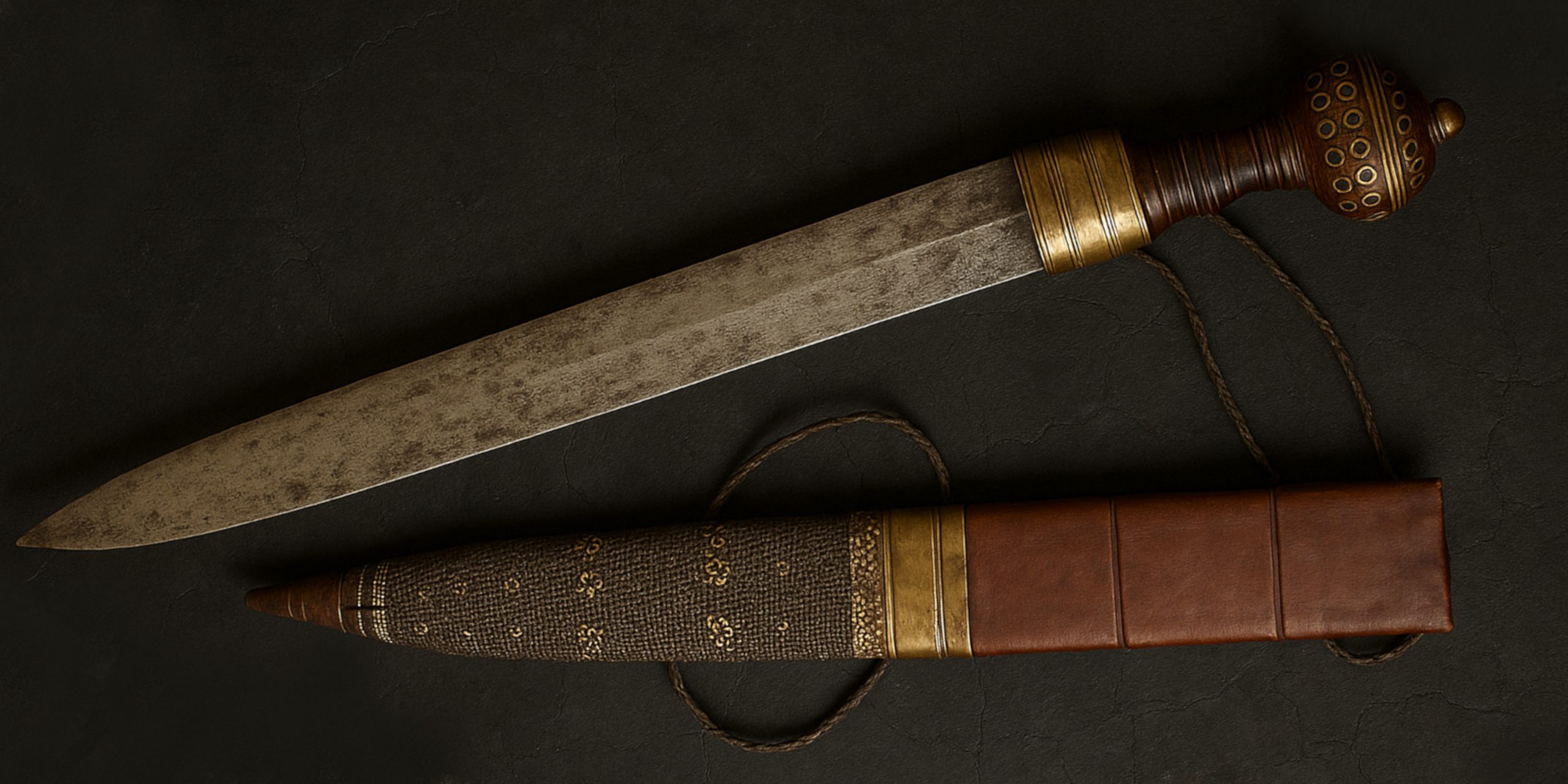
The Mandinka short sword is a traditional weapon from West Africa, primarily associated with the Mandinka people of the Mali Empire and its successor states. Compact, efficient, and steeped in symbolism, this blade reflects a martial culture that prized versatility and craftsmanship. Often carried as a sidearm by warriors and nobles alike, it represents both status and readiness for close combat.
Unlike the longer sabres of North Africa or the curved takouba of the Tuareg, the Mandinka short sword emphasised agility and precision. It was a weapon suited for sudden engagements, often complemented by spears or shields in battle.
Specification
| Feature | Description |
|---|---|
| Origin | Mandinka peoples of West Africa (Mali, Guinea, Senegal, Gambia) |
| Period of Use | c. 13th to 19th centuries |
| Overall Length | 40 to 60 cm |
| Blade Type | Double-edged or single-edged iron blade, broad and tapering |
| Blade Length | 25 to 45 cm |
| Hilt Material | Wood, bone, or horn, often wrapped in leather |
| Pommel | Rounded, conical, or disk-shaped for grip balance |
| Sheath | Leather, sometimes tooled with tribal patterns |
| Weight | Approximately 0.7 to 1.2 kg |
| Primary Function | Close combat, ceremonial display, personal defence |
History and Evolution
- Origins in the Mali Empire (13th–15th century)
The Mandinka short sword likely evolved during the height of the Mali Empire, when blacksmiths, known as numu, played a crucial social and spiritual role in weapon production. Early versions were simple iron blades used by both cavalry and foot soldiers. - Regional Variations (16th–18th century)
As Mandinka communities spread through trade and conquest, local variations emerged. Some blades featured straighter profiles for stabbing, while others curved slightly for slashing efficiency. Handles became more decorative, often reflecting clan identity. - Symbol of Status (19th century)
By the 1800s, the weapon was often ceremonial. Chiefs and griots carried finely crafted examples as symbols of authority and heritage, with blades occasionally adorned with brass inlays or geometric engraving. - Decline and Preservation (20th century)
With the introduction of firearms and colonial restructuring, the sword’s military role diminished. However, it remained a significant cultural artefact, retained in dance rituals and traditional ceremonies.
Advantages and Disadvantages
Advantages
- Compact size ideal for quick, close-quarters combat.
- Durable iron construction suitable for both cutting and thrusting.
- Simple design allowed efficient production by local smiths.
- Lightweight and easily carried on the hip or in the belt.
- Culturally significant, often used in rituals and ceremonies.
Disadvantages
- Short range limited effectiveness against polearms or cavalry.
- Lacked the reach and cutting power of larger sabres.
- Functional simplicity sometimes came at the expense of refinement.
- Many surviving examples are corroded or fragmented due to tropical conditions.
Comparison with Similar Weapons
| Weapon | Region | Blade Type | Key Difference |
|---|---|---|---|
| Takouba | Tuareg (Sahara) | Straight, double-edged | Longer blade, used by mounted warriors |
| Kaskara | Sudan | Straight, double-edged | More refined, often with European influence |
| Yoruba Short Sword | Nigeria | Single-edged | Heavier blade, often symbolic or ritual use |
| Flyssa | Algeria | Narrow, tapering blade | More ornate, designed for slicing rather than thrusting |
| Mandinka Short Sword | West Africa | Broad, short blade | Practical hybrid for slashing and thrusting in tight formations |
Legacy
The Mandinka short sword endures as a testament to the West African blacksmith’s artistry and the martial identity of the Mali Empire’s descendants. It symbolises resilience, craftsmanship, and continuity of tradition. Today, it stands not only as a historical weapon but as a cultural emblem featured in museums and private collections around the world.
Its influence can be traced through West African diaspora art and ceremonial regalia, where echoes of its form appear in dance weapons and prestige items.
Where to See
| Location | Institution | Notable Pieces |
|---|---|---|
| Bamako, Mali | National Museum of Mali | Several Mandinka short swords from the 18th–19th centuries |
| Dakar, Senegal | IFAN Museum of African Arts | Blades with leatherwork scabbards and engraved motifs |
| London, UK | British Museum | Early examples acquired during colonial expeditions |
| Paris, France | Musée du Quai Branly | Fine ceremonial swords with brass inlays |
| Washington, D.C. | Smithsonian National Museum of African Art | Short swords with distinctive horn grips |
Collector’s Guide and Auction Prices
Collecting Tips
- Verify authenticity through material analysis and provenance.
- Look for intact sheaths and handle wrappings, which greatly increase value.
- Avoid heavily restored examples unless restoration is transparently documented.
- Beware of tourist reproductions from the 20th century with overly polished finishes.
Market Overview
| Condition | Period | Typical Price Range (GBP) | Notes |
|---|---|---|---|
| Excellent (museum-grade) | 18th–19th century | £1,200 – £2,800 | Complete examples with original leather sheaths |
| Good (display quality) | 19th century | £600 – £1,200 | Minor corrosion, solid structure |
| Fair (fragmentary or restored) | 19th–20th century | £200 – £500 | Common at African arms auctions |
| Reproduction / ceremonial modern | 20th century | £50 – £150 | Decorative value only |
Auction Houses and Galleries
- Bonhams African and Tribal Art (London)
- Christie’s Tribal Collections (Paris)
- Sotheby’s Arts d’Afrique (New York and Paris)
- Czerny’s Auction House (Italy)
The Seven Swords Takeaway
The Mandinka short sword remains one of the most evocative weapons of West African heritage. More than a blade, it embodies centuries of craftsmanship, social identity, and artistry. Whether seen in a museum display or held in a private collection, it continues to tell the story of a people whose iron and fire forged one of Africa’s greatest empires.



